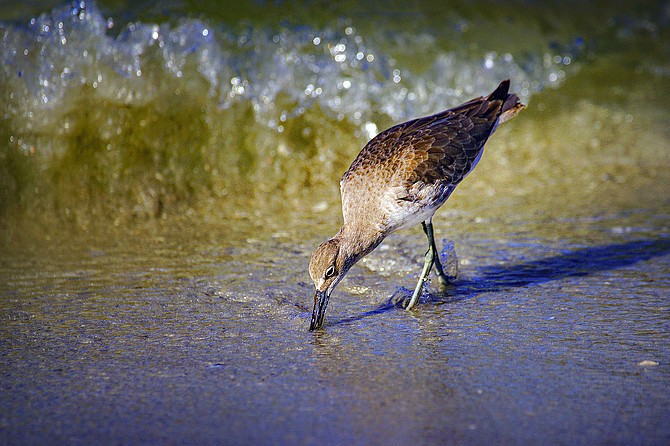 Facebook
Facebook
 X
X
 Instagram
Instagram
 TikTok
TikTok
 Youtube
Youtube

Sandpipers are now being seen in considerable numbers within San Diego County’s coastal wetland habitats and along the ocean beaches. Some have just arrived from the north; others are juveniles that have bred locally. You’ll find sanderlings and willets scurrying along the wet sand on the beaches. Several other members of the sandpiper family can be found in mudflat areas such as the Tijuana River Estuary, the south end of San Diego Bay, the San Diego River flood channel near Sea World, and the margins of most North County lagoons.
Extreme Low Tides early next week (the lowest levels for the month of August) occur during the wee hours of the morning. Thursday, August 11, features a -1.56 foot tide at 3:43am. On Friday, August 12, there’s a -1.49 foot low tide at 4:23am. Spring and summer extreme low tides typically occur at such inconvenient times of the day. Starting in October and continuing through the winter season, favorable low-tide episodes will coincide with afternoon hours, and it will be possible to view in daylight the lowest and richest tidepools along San Diego County’s coastline.
Ocean Water Temperatures are probably peaking now, the result of many weeks of summer sunshine and warm coastal air temperatures. While the water offshore seldom exceeds 70° Fahrenheit, shallow-water temperatures of 70°-80° are not uncommon on gently shelving beaches late in the day. Wide, sandy beaches such as Coronado, south Mission Beach, and La Jolla Shores are now at their best for comfortable bathing.

August 11th's full moon has many names, one being the Sturgeon Moon, and it rounds out this year’s parade of four supermoons, which started in May. Supermoons are ever-so-slightly closer to Earth than the average full Moon, which technically makes them extra large and bright from Earth’s perspective. August’s full Moon was traditionally called the Sturgeon Moon because the giant sturgeon of the Great Lakes and Lake Champlain were most readily caught during this part of summer. Other names include: Corn Moon, Harvest Moon, and Ricing Moon, and signify the time to gather mature crops.
The above comes from the Outdoors listings in the Reader compiled by Jerry Schad, author of Afoot & Afield in San Diego County. Schad died in 2011. Planet information from SkyandTelescope.org.


Sandpipers are now being seen in considerable numbers within San Diego County’s coastal wetland habitats and along the ocean beaches. Some have just arrived from the north; others are juveniles that have bred locally. You’ll find sanderlings and willets scurrying along the wet sand on the beaches. Several other members of the sandpiper family can be found in mudflat areas such as the Tijuana River Estuary, the south end of San Diego Bay, the San Diego River flood channel near Sea World, and the margins of most North County lagoons.
Extreme Low Tides early next week (the lowest levels for the month of August) occur during the wee hours of the morning. Thursday, August 11, features a -1.56 foot tide at 3:43am. On Friday, August 12, there’s a -1.49 foot low tide at 4:23am. Spring and summer extreme low tides typically occur at such inconvenient times of the day. Starting in October and continuing through the winter season, favorable low-tide episodes will coincide with afternoon hours, and it will be possible to view in daylight the lowest and richest tidepools along San Diego County’s coastline.
Ocean Water Temperatures are probably peaking now, the result of many weeks of summer sunshine and warm coastal air temperatures. While the water offshore seldom exceeds 70° Fahrenheit, shallow-water temperatures of 70°-80° are not uncommon on gently shelving beaches late in the day. Wide, sandy beaches such as Coronado, south Mission Beach, and La Jolla Shores are now at their best for comfortable bathing.

August 11th's full moon has many names, one being the Sturgeon Moon, and it rounds out this year’s parade of four supermoons, which started in May. Supermoons are ever-so-slightly closer to Earth than the average full Moon, which technically makes them extra large and bright from Earth’s perspective. August’s full Moon was traditionally called the Sturgeon Moon because the giant sturgeon of the Great Lakes and Lake Champlain were most readily caught during this part of summer. Other names include: Corn Moon, Harvest Moon, and Ricing Moon, and signify the time to gather mature crops.
The above comes from the Outdoors listings in the Reader compiled by Jerry Schad, author of Afoot & Afield in San Diego County. Schad died in 2011. Planet information from SkyandTelescope.org.
Comments